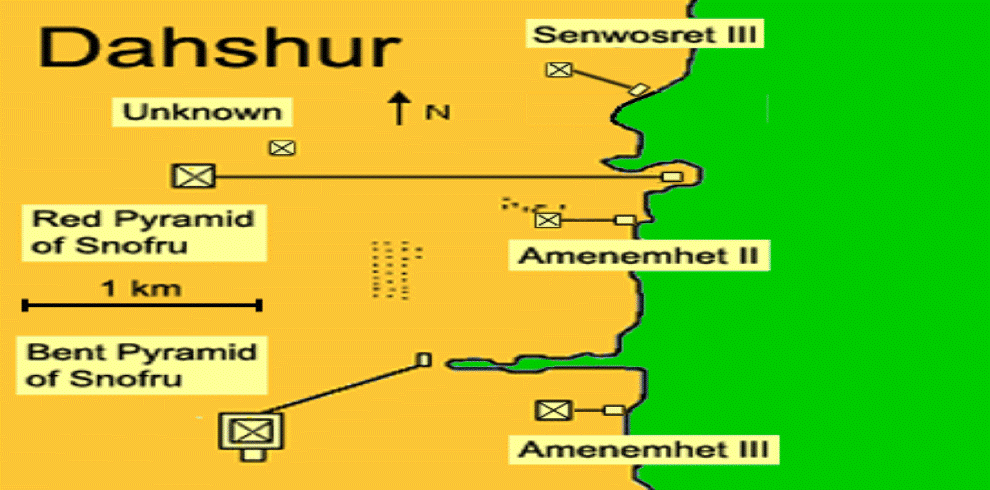Dahshur is a desert plateau located about seven kilometers to the south of Saqqara, the central necropolis of Memphis, capital of Egypt during the Old Kingdom. The name Dahshur, derived from the ancient name (Ikntor) which it is a tree called (Christ’s Thorn). The vast necropolis of Dahshur is one of the large pyramid cemeteries of the Old and Middle Kingdom (2600–1700 BCE). The appearance of the natural landscape at Dahshur was intensely altered by human impact, especially through mining. The quarries of the pyramids appear today as scarps and depressions.5 The channel beds in the wadis leading to the Bent Pyramid were also altered by use as transport paths for building material and by fluvial erosion.
For whatever reason, in about the 15th year of his reign, Sneferu abandoned Meidum and moved 40 km north to Dahshur. Here he founded another new necropolis – all the more unusual since Meidum itself represented the first time a royal necropolis had been laid out at a virgin site since the founding of Saqqara. One suggested a motive for the move was Sneferu’s desire to be closer to the apex of the Delta and to the increasingly important trade with Syria and the Levant.
At Dahshur Sneferu built two large pyramids – the Bent Pyramid and the North or the Red Pyramid. The two are roughly aligned – the east side of the North Pyramid approximately lining up with the west side of the Bent Pyramid. A long causeway from the Bent Pyramid runs to what is often described as the first valley temple, but which in fact is some distance into the desert. Northeast of the Bent Pyramid a cemetery of mastabas was begun. Decorated with relief-carved chapels, the tombs were for the elite of Sneferu’s court.
In 1936 Rainer Stadelmann excavated Lepsius pyramid number 50. It is 250 m east of the North Pyramid and consists of the base of a pyramid that was barely begun. On the east side were large limestone blocks and a brick ramp that may have been intended for building the subterranean apartment. The pottery in the vicinity appeared to the 4th dynasty.
A study suggests that the pair of the gigantic pyramids at Dahshur were finished and even perhaps conceived, as a unique project where, apart from the strongly symbolic aspect and the obligation of accomplishing the king’s needs for the hereafter, Sneferu was able to demonstrate his dominion over all the land by the mere contemplation of his monuments.
Earlier Egyptologists who had dealt with Dahshur doubted that the Bent pyramid was built by Sneferu simply because it was finished complete with casing stones, enclosure wall, subsidiary or satellite pyramid, and both a valley and pyramid temples. Actually, most citations of (kha-snfrw-rsy) were thought to refer to the pyramid of Meidum which certainly was to the ‘south’ (rsy) of Dahshur. It was only after Fakhry’s work on-site and the clear adscription of the Bent pyramid to Sneferu that the story of the ‘fake’ or ‘failed’ pyramid polluted Egyptological literature.
Middle Kingdom pharaohs also chose Dahshur as the site of their pyramids, beginning with Amenemhat II. Those of Amenemhat III and Senwosret III are of mudbrick, and in some ways Amenemhat III’s looks like a mudbrick version of the Meidum Pyramid. Interestingly, just as Sneferu had serious structural problems when building his Bent Pyramid at Dahshur because of the unstable desert sand, gravel and clays it was founded on, so Amenemhat III, building on a similar surface, encountered subsidence and cracking. This probably explains why he built another pyramid at Hawara, just as Sneferu built a substitute pyramid to the north of the first at Dahshur.
Two of Sneferu’s sons, Nefermaat and the anonymous prince of mastaba 17, were buried at Meidum. Another son, Kanefer, was buried in one of the clusters of tombs near the pyramid of Amenemhat II. These three sons should have inherited the throne which passed instead to Khufu – who may have been very young when he began to build his pyramid. This perhaps explains the confidence with which he started out on his gigantic program at Giza.
Despite having built two giant pyramids at Dahshur, one of which was to be for his burial, Sneferu was apparently still not content and returned to Meidum to finish off his pyramid there.

